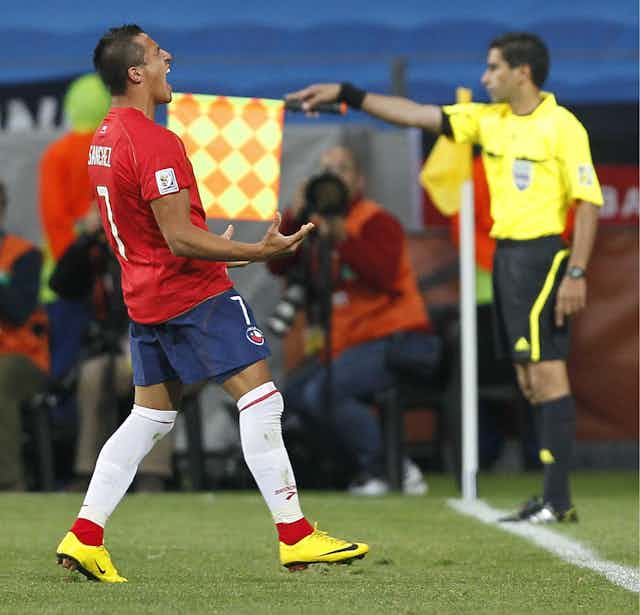The offside rule is perhaps one of the most controversial rules ever applied to football.
We only need to look to Mexico vs Cameroon on day two of the 2014 World Cup. Thank god for the 61st minute goal by Peralta, otherwise a nil-all draw would have been hard for the Mexicans to digest after two controversial offside calls denying a deserved lead in the first half.
In simple terms, the rule (or “law” as FIFA calls it) explains that a player is considered offside if he or she receives the ball while being “beyond” the second last opponent (usually a defender).
Indeed, the official text of Law 11 of the FIFA 2014/2015 Laws of the Game states, in a very straightforward manner, that:
It is not an offence in itself to be in an offside position. A player is in an offside position if he is nearer to his opponents’ goal line than both the ball and the second-last opponent.

There are a couple of exceptions, though – there’s no offside offence if a player receives the ball directly from a throw-in, goal kick or corner kick.
A player is not in an offside position if:
- he is in his own half of the field of play or
- he is level with the second-last opponent or
- he is level with the last two opponents.

Why have the rule at all?
The offside law is not a modern creation. A primordial version was already present in the first issue of football laws created by the English Football Association in 1863, but the law sanctioned any player who was found ahead of the ball, probably making the game very static (not to mention confusing).
The offside law was still enforced when the International Football Association Board (IFAB) was created in 1886, and adopted by FIFA upon joining the IFAB in 1913.
After receiving a tweak in 1990, the law continues to be slightly modified to make its interpretation easier for the assistant referees (the official title of the linesmen).
So, can such a simple rule generate a century-long controversy, forcing FIFA to change it numerous times since its introduction?
It appears to be so, and some resounding examples of flag mistakes still make football fans upset all over the world.
One of the most famous controversies remains the goal scored by Cameroonian footballer Samuel Eto’o, then playing for FC Barcelona, in the 76th minute of the 2006 UEFA Champions League final between FC Barcelona and Arsenal FC.
With Arsenal leading 1-0 in the final half, the game could have been very different if the offside had been correctly sanctioned.
Such mistakes can not only change a football game, but can also signify a loss in revenue of €3-4 million – such is the difference between winning and losing a final.
Refereeing: it’s a tough job
In all fairness, quick actions such as the one that led to Barcelona’s equaliser are not easy to judge for the assistant referees.

Now we also have some growing evidence of the science behind making a decision to sanction or not an offside … and it’s not easy business!
Almost 15 years ago Raoul Oudejans and colleagues from the Vrije Universiteit in the Netherlands attributed the cause of offside judgement errors to a problem in the optical perception of the players due to the visual angle of the assistant referees.
This was a first attempt to dispel the common myth between football fans that assistant referees make mistakes due to the fact that they have to continuously move their vision from the attacker-defender couple to the player passing the ball, as then confirmed experimentally.
Later, Werner Helsen and colleagues from the University of Leuven in Belgium refined the explanation of offside mistakes by focusing on the so called “flash-lag” effect, where an object moving fast (such as the attacker) is perceived ahead of its real position when the observer is prompted by a sudden stimulus (the ball being passed by a midfielder).
Despite this apparent perceptual disadvantage in their job and the constant social pressure, assistant referees only judged incorrectly on 10% of the occasions during the 2006 World Cup.
Having said that, not even science can explain some of the most unbelievably missed offside calls, such as the episode in FC Schalke 04 vs FC Basel in the 2013 Champions League.
That’s a mystery, and is probably why offside will remain controversial for a long time and will supply precious material for jokes, TV commentaries and fan rivalries.
Many have called for the introduction of an official video review, similar to those successfully implemented in other football codes.
It’s hard to tell if FIFA will say yes to that. Perhaps giving football fans the possibility to be an assistant referee through videogames or virtual reality applications concurrently with major tournaments could help everyone to better understand the “human” side of offside … something worth considering.

